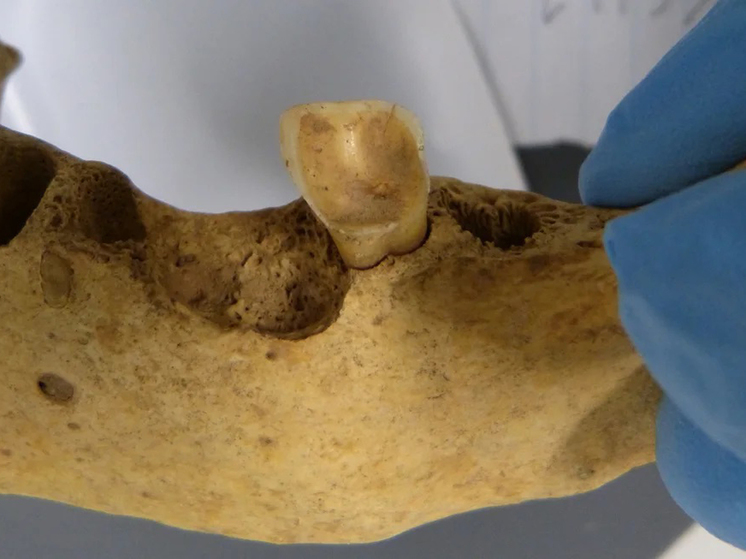Diet changes can affect oral health
Ancient teeth rarely harbor the cavity-causing bacteria commonly found today. New research shows why. Two teeth from a man who lived approximately 4,000 years ago were found to contain an abundance of the bacteria that primarily cause tooth decay and gum disease. The rare find could help scientists better understand how changes in human diet led to the prevalence of tooth decay today.
 Photo: Trinity College Dublin
Photo: Trinity College Dublin
Discovered during two excavations in 1993 and 1996, the teeth were among several human teeth and other remains found in a limestone cave in County Limerick in Ireland, CNN reports. According to a paper published Wednesday in the journal Molecular Biology and Evolution, both samples of molars, dating between 2280 and 2140 BC, belonged to the same individual who lived during the Bronze Age.
One tooth was found to have a surprising abundance of Streptococcus mutans (S. mutans), an oral bacteria that causes tooth decay. According to Lara Cassidy, the paper's senior author and associate professor of genetics at Trinity College Dublin, the bacterium is rare in the ancient genomic record, likely because it is poorly preserved due to its acid-forming nature, which causes tooth decay and DNA degradation in teeth.
Researchers also believe that bacteria were not as common in ancient teeth because human diets included less refined sugar and processed foods than consumed today, Lara Cassidy said. A major shift in diets occurred with the advent of agriculture about 10,000 years ago, but major changes have occurred in the last few hundred years due to the popularization of sugar, she added.
It is unclear why the bacteria on the newly discovered tooth survived so good, but Cassidy emphasizes that the cave's cool, dry conditions were likely factors.
While cavities have been observed in other ancient dental finds, S. mutans has only been found in very small quantities in a handful of remains, such as an older Neolithic tooth from southwestern France (dated between 3400 and 2900 BC). ) or chewed gum from the Scandinavian Mesolithic (dating between 9890 and 9540 BC). According to the article, observations of cavities in other ancient teeth became more frequent after the introduction of grain farming, the cultivation of grain crops such as wheat and barley.
By analyzing bacteria found on Bronze Age teeth and comparing them to modern samples, the researchers discovered that the ancient evolutionary tree of S. mutans was more complex than originally thought and found that traits of ancient bacteria such as virulence (the ability to cause harm) , evolved in parallel with changes in the human body. diet, including the promotion of sugar and cereal grains, Cassidy said.
“There has been a crazy amount of change (in the human diet) over the past few hundred years, so it is especially important to understand how this has affected the microbiome (microorganisms, such as bacteria, that naturally live on and in the human body), not only oral microbiome, but also on the intestinal microbiome. Just help us understand a little bit about why certain diseases have become so common in Western populations or Westernized populations over the last few centuries,” she added.
The Bronze Age teeth showed no signs of tooth decay, Cassidy said, but if the adult male who owned them had lived a little longer, the abundance of bacteria present suggests he would have soon developed cavities.
Two of the teeth also contained DNA evidence of Tannerella forsythia (T. forsythia), a gum disease-causing bacterium that is more common in ancient genome records. But researchers found two different strains of bacteria in teeth — today, only one strain of bacteria is typically found, implying that ancient microbiomes were much more diverse than modern ones. The loss of biodiversity is a concern because it could have negative impacts on human health, Trinity College Dublin said in a press release.
Several other teeth found in the cave showed signs of decay, but it is unknown whether the remains belonged to the same person or other members of the community because they were found dismembered, separated from other skeletal remains, Cassidy said. “It is possible that other teeth in his mouth did have decay, or that other members of his community suffered from dental disease.”
Analysis of ancient S. mutans shows that the bacterium has become more common in recent centuries due to sugar consumption, which created a favorable habitat for the species in the human mouth, Cassidy added. Understanding the origins of modern tooth decay-causing bacteria further helps scientists understand how changes in diet may affect oral health today, she said.
Analysis of ancient S. mutans compared with modern S. mutans “revealed major changes over the past few hundred years associated with increased sugar consumption” and confirms previous studies that found higher rates of tooth decay after refined sugar became widely available in the 19th century, said Louise Humphrey, director of the study at the Center for Research in Human Evolution at the Natural History Museum in London.
&ldquo ;The oral microbiome is important in many areas of human health and disease. Ancient teeth can help us understand how the human oral microbiota (a range of microorganisms) has evolved over time and the impact of these changes on human health in the past and today,” Humphrey emphasizes.


